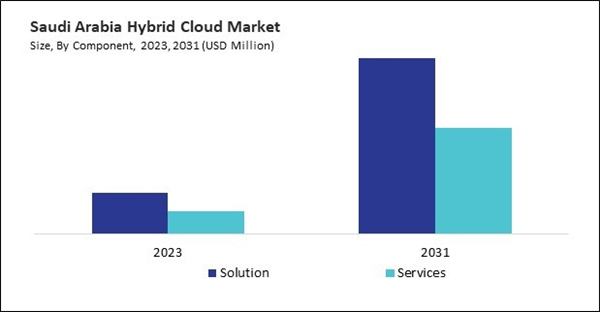The Brazil market dominated the LAMEA Hybrid Cloud Market by Country in 2023, and would continue to be a dominant market till 2031; thereby, achieving a market value of $6.13 billion by 2031. The Argentina market is registering a CAGR of 20.2% during (2024 - 2031). Additionally, the UAE market would showcase a CAGR of 18.4% during (2024 - 2031).
Adopting hybrid cloud solutions has been driven by technological advancements, business needs, and market trends. Hybrid cloud adoption allows organizations to adjust their compliance strategies dynamically based on evolving regulations.
Moreover, organizations can store sensitive data on private clouds to meet strict regulatory requirements while leveraging public clouds for less regulated operations. Organizations operating in multiple regions can use a hybrid cloud to comply with local data residency and privacy laws.
Digitalization in healthcare generates vast amounts of data from electronic health records (EHRs), telemedicine, and IoT devices. Hybrid cloud solutions provide the infrastructure needed to manage, store, and analyze this data efficiently, ensuring secure and accessible healthcare information across Saudi Arabia. As per the International Trade Administration (ITA), Saudi Arabia is projected to be one of the fastest-growing digital health markets in the GCC region. The government has allocated $1.5 billion towards healthcare IT and digital transformation initiatives. The government has implemented an e-health strategy to enhance telemedicine to improve accessibility and quality of care in remote areas.
Based on Component, the market is segmented into Solution and Services. Based on Enterprise Size, the market is segmented into Small & Medium-sized Enterprises and Large Enterprises. Based on Service Model, the market is segmented into Software as a Service (SaaS), Infrastructure as a Service (IaaS), and Platform as a Service (PaaS). Based on Industry Vertical, the market is segmented into BFSI, IT & Telecom, Healthcare, Retail, Government, Media & Entertainment, Transportation & Logistics, Manufacturing, and Others. Based on countries, the market is segmented into Brazil, Argentina, UAE, Saudi Arabia, South Africa, Nigeria, and Rest of LAMEA.
List of Key Companies Profiled
- Amazon Web Services, Inc. (Amazon.com, Inc.)
- Microsoft Corporation
- Google LLC
- IBM Corporation
- Oracle Corporation
- SAP SE
- Salesforce, Inc.
- Dell Technologies, Inc.
- Equinix, Inc.
- Nutanix, Inc.
Market Report Segmentation
By Component
- Solution
- Services
By Enterprise Size
- Small & Medium-sized Enterprises
- Large Enterprises
By Service Model
- Software as a Service (SaaS)
- Infrastructure as a Service (IaaS)
- Platform as a Service (PaaS)
By Industry Vertical
- BFSI
- IT & Telecom
- Healthcare
- Retail
- Government
- Media & Entertainment
- Transportation & Logistics
- Manufacturing
- Others
By Country
- Brazil
- Argentina
- UAE
- Saudi Arabia
- South Africa
- Nigeria
- Rest of LAMEA
Table of Contents
Companies Mentioned
- Amazon Web Services, Inc. (Amazon.com, Inc.)
- Microsoft Corporation
- Google LLC
- IBM Corporation
- Oracle Corporation
- SAP SE
- Salesforce, Inc.
- Dell Technologies, Inc.
- Equinix, Inc.
- Nutanix, Inc.
Methodology

LOADING...









